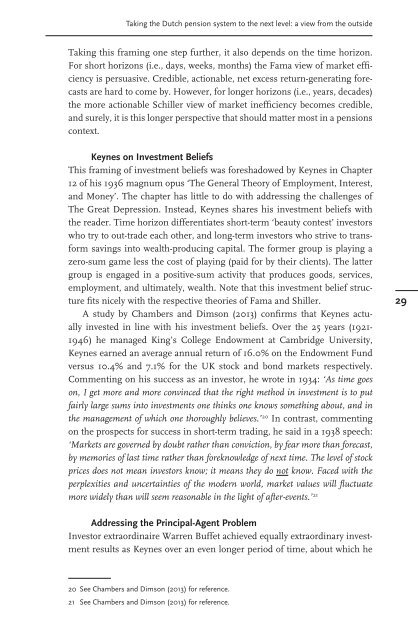Toekomst voor aanvullende pensioenen
Toekomst voor aanvullende pensioenen
Toekomst voor aanvullende pensioenen
- No tags were found...
You also want an ePaper? Increase the reach of your titles
YUMPU automatically turns print PDFs into web optimized ePapers that Google loves.
Taking the Dutch pension system to the next level: a view from the outsideTaking this framing one step further, it also depends on the time horizon.For short horizons (i.e., days, weeks, months) the Fama view of market efficiencyis persuasive. Credible, actionable, net excess return-generating forecastsare hard to come by. However, for longer horizons (i.e., years, decades)the more actionable Schiller view of market inefficiency becomes credible,and surely, it is this longer perspective that should matter most in a pensionscontext.Keynes on Investment BeliefsThis framing of investment beliefs was foreshadowed by Keynes in Chapter12 of his 1936 magnum opus ‘The General Theory of Employment, Interest,and Money’. The chapter has little to do with addressing the challenges ofThe Great Depression. Instead, Keynes shares his investment beliefs withthe reader. Time horizon differentiates short-term ‘beauty contest’ investorswho try to out-trade each other, and long-term investors who strive to transformsavings into wealth-producing capital. The former group is playing azero-sum game less the cost of playing (paid for by their clients). The lattergroup is engaged in a positive-sum activity that produces goods, services,employment, and ultimately, wealth. Note that this investment belief structurefits nicely with the respective theories of Fama and Shiller.A study by Chambers and Dimson (2013) confirms that Keynes actuallyinvested in line with his investment beliefs. Over the 25 years (1921-1946) he managed King’s College Endowment at Cambridge University,Keynes earned an average annual return of 16.0% on the Endowment Fundversus 10.4% and 7.1% for the UK stock and bond markets respectively.Commenting on his success as an investor, he wrote in 1934: ‘As time goeson, I get more and more convinced that the right method in investment is to putfairly large sums into investments one thinks one knows something about, and inthe management of which one thoroughly believes.’ 20 In contrast, commentingon the prospects for success in short-term trading, he said in a 1938 speech:‘Markets are governed by doubt rather than conviction, by fear more than forecast,by memories of last time rather than foreknowledge of next time. The level of stockprices does not mean investors know; it means they do not know. Faced with theperplexities and uncertainties of the modern world, market values will fluctuatemore widely than will seem reasonable in the light of after-events.’ 2129Addressing the Principal-Agent ProblemInvestor extraordinaire Warren Buffet achieved equally extraordinary investmentresults as Keynes over an even longer period of time, about which he20 See Chambers and Dimson (2013) for reference.21 See Chambers and Dimson (2013) for reference.




![Proefschrift Hanneke A. Luth[lr]](https://img.yumpu.com/51055008/1/178x260/proefschrift-hanneke-a-luthlr.jpg?quality=85)

![Proefschrift Hanneke A. Luth[lr]](https://img.yumpu.com/24018368/1/178x260/proefschrift-hanneke-a-luthlr.jpg?quality=85)